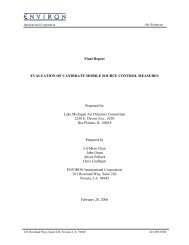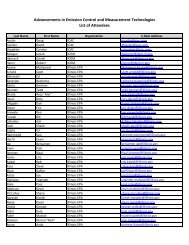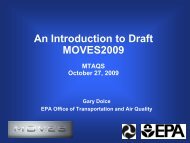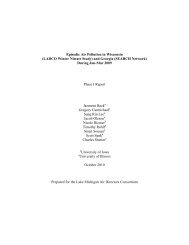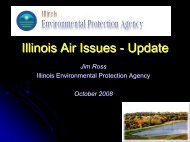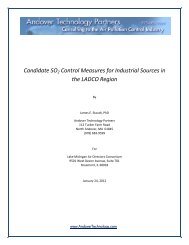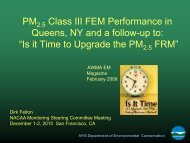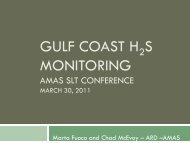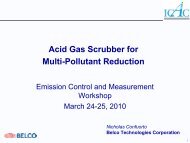Conceptual Model of PM2.5 Episodes in the Midwest - ladco
Conceptual Model of PM2.5 Episodes in the Midwest - ladco
Conceptual Model of PM2.5 Episodes in the Midwest - ladco
You also want an ePaper? Increase the reach of your titles
YUMPU automatically turns print PDFs into web optimized ePapers that Google loves.
Lake Michigan Air Directors Consortium<br />
<strong>Conceptual</strong> <strong>Model</strong><br />
<strong>of</strong> <strong>PM2.5</strong> <strong>Episodes</strong> <strong>in</strong><br />
<strong>the</strong> <strong>Midwest</strong><br />
LADCO PM Data Analysis Workgroup<br />
January 2009
Table <strong>of</strong> Contents<br />
Executive Summary ..............................................................................................1<br />
Introduction ...........................................................................................................2<br />
Current Conditions and Trends .............................................................................2<br />
Temporal and Spatial Patterns <strong>of</strong> <strong>PM2.5</strong>...............................................................7<br />
<strong>PM2.5</strong> Composition.............................................................................................12<br />
Source Apportionment.........................................................................................16<br />
<strong>PM2.5</strong> Sensitivity to Changes <strong>in</strong> Precursor Concentrations ................................18<br />
Meteorological Analyses .....................................................................................20<br />
W<strong>in</strong>d Roses.........................................................................................................20<br />
CART Analysis ....................................................................................................23<br />
Trajectory Analysis..............................................................................................29<br />
Synoptic Meteorology..........................................................................................32<br />
Conclusions.........................................................................................................35<br />
Control Recommendations..................................................................................36<br />
References..........................................................................................................36<br />
Supplemental Material.........................................................................................38<br />
Figures<br />
Fig. 1 98 th Percentile <strong>PM2.5</strong> Concentrations, 20052007.....................................4<br />
Fig. 2 Trends <strong>in</strong> 98 th Percentiles, LADCO States, 19992007 ..............................4<br />
Fig. 3 L<strong>in</strong>ear Least Squares and Theil Trends <strong>of</strong> <strong>PM2.5</strong> Values<br />
Greater than <strong>the</strong> 90 th Percentile at Wiscons<strong>in</strong> SE Headquarters<br />
Site (Milwaukee)....................................................................................................5<br />
Fig. 4 Theil Trends <strong>in</strong> 98 th Percentile Values , 19992007, at <strong>PM2.5</strong> Sites...........5<br />
Fig. 5 Frequency <strong>of</strong> Elevated <strong>PM2.5</strong> Concentrations by City ...............................8<br />
Fig. 6 Frequency <strong>of</strong> Elevated <strong>PM2.5</strong> Concentrations by Month<br />
(Sou<strong>the</strong>rn Cities) ...................................................................................................9<br />
Fig. 7 Frequency <strong>of</strong> Elevated <strong>PM2.5</strong> Concentrations by Month<br />
(Nor<strong>the</strong>rn Cities)..................................................................................................10<br />
Fig. 8 Day<strong>of</strong>Week Variation <strong>in</strong> High <strong>PM2.5</strong> Concentrations<br />
(Nor<strong>the</strong>rn Cities)..................................................................................................11<br />
Fig. 9 <strong>PM2.5</strong> Composition on Episode and Nonepisode Days <strong>in</strong><br />
Urban Areas (2005).............................................................................................12<br />
Fig. 10 Ratio <strong>of</strong> Bulk Species Concentrations on High Days to All<br />
Days at Allen Park, MI.........................................................................................13<br />
Fig. 11 <strong>PM2.5</strong> Composition on Summer 2005 Episode and<br />
Nonepisode Days................................................................................................14<br />
ii
Fig. 12 <strong>PM2.5</strong> Composition on W<strong>in</strong>ter 2005 Episode and<br />
Nonepisode Days.................................................................................................. 14<br />
Fig. 13 UrbanRural Comparison <strong>of</strong> Major <strong>PM2.5</strong> Components ........................... 15<br />
Fig. 14 PMF Contributions at (a) Allen Park, MI, and (b) Dearborn, MI ............... 17<br />
Fig. 15 Ratios <strong>of</strong> Metal Concentrations on High Days to All Days ....................... 18<br />
Fig. 16 Locations <strong>of</strong> Ammonia Monitor<strong>in</strong>g Sites ................................................... 19<br />
Fig. 17 Isopleths <strong>of</strong> mean predicted <strong>PM2.5</strong> mass concentrations<br />
from SCAPE model results for Mayville, Wiscons<strong>in</strong> .............................................. 20<br />
Fig. 18 Seasonal W<strong>in</strong>d Roses for Indianapolis..................................................... 21<br />
Fig. 19 EpisodeDay W<strong>in</strong>d Roses for 8 Urban Areas ........................................... 22<br />
Fig. 20 Chicago CART Tree ................................................................................. 27<br />
Fig. 21 Distribution <strong>of</strong> Chicago Episode Days among CART Nodes .................... 28<br />
Fig. 22 Timel<strong>in</strong>e <strong>of</strong> Chicago <strong>Episodes</strong>, by Node................................................... 28<br />
Fig. 23 Trends <strong>in</strong> Chicago HighConcentration Nodes ......................................... 29<br />
Fig. 24 Back Trajectory Analysis <strong>of</strong> High Sulfate Source Regions<br />
and High Nitrate Source Regions.......................................................................... 31<br />
Fig. 25 September 4, 2004 – Surface Wea<strong>the</strong>r Map ............................................ 33<br />
Fig. 26 AIRNow <strong>PM2.5</strong> Maps – September 5 & 6, 2004 ...................................... 34<br />
Fig. 27 Sulfate & Nitrate Concentrations – Indianapolis, IN –<br />
September 26, 2004............................................................................................. 35<br />
Tables<br />
Table 1 Annual Trend <strong>in</strong> Pm2.5 Values above 90 th Percentile (ug/m3/year)........ 6<br />
Table 2 Valid Monitor<strong>in</strong>g Days and High Pm2.5 Days, by Urban Area................. 7<br />
Table 3 Coherence <strong>of</strong> High <strong>PM2.5</strong> Days across <strong>the</strong> Detroit Network................... 11<br />
Table 4 Variables <strong>in</strong>cluded <strong>in</strong> CART Analysis ...................................................... 24<br />
iii
Executive Summary<br />
A <strong>Conceptual</strong> <strong>Model</strong> <strong>of</strong> <strong>PM2.5</strong> <strong>Episodes</strong> <strong>in</strong> <strong>the</strong> <strong>Midwest</strong><br />
Draft Report <strong>of</strong> <strong>the</strong> LADCO PM Data Analysis Workgroup 1<br />
Nonatta<strong>in</strong>ment <strong>of</strong> <strong>the</strong> 24hr <strong>PM2.5</strong> ambient air quality standard is a widespread problem<br />
across <strong>the</strong> LADCO states, with 57 <strong>of</strong> 126 monitors exceed<strong>in</strong>g <strong>the</strong> standard <strong>in</strong> 2005<br />
2007. This study exam<strong>in</strong>ed ambient <strong>PM2.5</strong> and meteorological data from 19992007<br />
along with several draft or published studies <strong>of</strong> LADCO projects for clues to <strong>the</strong> nature<br />
<strong>of</strong> elevated <strong>PM2.5</strong> episodes <strong>in</strong> <strong>the</strong> LADCO 5state region. Despite <strong>the</strong> varied analyses,<br />
<strong>the</strong> results were remarkably consistent. <strong>PM2.5</strong> episodes generally occur across broad<br />
geographic areas <strong>in</strong>volv<strong>in</strong>g multiple cities and states. The composition <strong>of</strong> <strong>PM2.5</strong><br />
<strong>in</strong>dicates that regional sources are <strong>the</strong> primary contributors dur<strong>in</strong>g episodes.<br />
Ammonium sulfate is always elevated dur<strong>in</strong>g episodes regardless <strong>of</strong> season.<br />
W<strong>in</strong>tertime <strong>PM2.5</strong> dur<strong>in</strong>g episodes <strong>of</strong>ten is strongly enriched <strong>in</strong> ammonium nitrate,<br />
especially at <strong>the</strong> nor<strong>the</strong>rn sites <strong>in</strong> <strong>the</strong> region. Organic carbon is elevated dur<strong>in</strong>g both<br />
summer and w<strong>in</strong>ter episodes, although to a lesser degree than sulfate and nitrate. In<br />
contrast, components <strong>of</strong> <strong>PM2.5</strong> that are typically associated with <strong>in</strong>dustrial sources<br />
(metals and crustal species) are not significantly enriched dur<strong>in</strong>g episodes.<br />
High daily concentrations are driven by specific meteorological conditions, not by a<br />
sudden <strong>in</strong>crease <strong>in</strong> emissions from sources. <strong>Episodes</strong> are characterized by stagnant air<br />
masses accompanied by high pressure, slow w<strong>in</strong>d speeds, high relative humidity, and<br />
sou<strong>the</strong>rly w<strong>in</strong>ds. The longer <strong>the</strong>se conditions persist, <strong>the</strong> higher concentration build up,<br />
until a new wea<strong>the</strong>r system arrives with cleaner air.<br />
While <strong>PM2.5</strong> concentrations have decl<strong>in</strong>ed across <strong>the</strong> region s<strong>in</strong>ce 1999,<br />
meteorologically adjusted trends <strong>in</strong>dicate that <strong>the</strong>se changes may be driven more by<br />
yeartoyear variations <strong>in</strong> meteorology than by changes <strong>in</strong> emissions. Sensitivity<br />
analyses <strong>in</strong>dicate that reductions <strong>in</strong> SO2 emissions would be effective at reduc<strong>in</strong>g<br />
<strong>PM2.5</strong> concentrations yearround across <strong>the</strong> region. W<strong>in</strong>tertime decreases <strong>of</strong> both<br />
ammonia and NOx would be effective, with most sites respond<strong>in</strong>g slightly more to<br />
ammonia reductions than to NOx. Organic carbon reductions would also be effective<br />
both regionally and locally.<br />
1 Contributors: Bill Adamski, WDNR; Michele Boner, IDEM; Brian Callahan, IDEM; Michael Compher,<br />
USEPA R5; Jim Haywood, MDEQ; Cynthia Hodges, MDEQ; Donna Kenski, LADCO; Sam Rubens, Akron<br />
AQMD; Bart Sponseller, WDNR.,<br />
1
Introduction<br />
In September 2006, U.S. Environmental Protection Agency (EPA) lowered <strong>the</strong> 24hour<br />
<strong>PM2.5</strong> National Ambient Air Quality Standard (NAAQS) from 65 ug/m3 to 35 ug/m3.<br />
Unlike <strong>the</strong> annual standard, which averages all measurements <strong>of</strong> <strong>PM2.5</strong> over <strong>the</strong> entire<br />
year, <strong>the</strong> form <strong>of</strong> <strong>the</strong> daily standard is a 98 th percentile. Its target is extreme events, or<br />
episodes, <strong>in</strong> which concentrations are significantly higher than average. As states beg<strong>in</strong><br />
to plan how <strong>the</strong>y can meet <strong>the</strong> tighter standard, <strong>in</strong>formation about <strong>PM2.5</strong> episodes<br />
becomes <strong>in</strong>creas<strong>in</strong>gly important. This report is an effort to collect and organize<br />
<strong>in</strong>formation about <strong>PM2.5</strong> episodes <strong>in</strong> <strong>the</strong> <strong>Midwest</strong> <strong>in</strong> order to improve our understand<strong>in</strong>g<br />
<strong>of</strong> <strong>the</strong> behavior <strong>of</strong> <strong>PM2.5</strong> and <strong>the</strong> factors that are most <strong>in</strong>fluential to <strong>the</strong> development <strong>of</strong><br />
high concentrations. In this report, we summarize current concentrations and trends,<br />
spatial and temporal variability, composition, urbanrural differences, source<br />
contributions, and meteorological factors associated with PM episodes. The analyses<br />
focus on major urban areas <strong>in</strong> <strong>the</strong> LADCO region. The message that emerges from<br />
<strong>the</strong>se various analyses is surpris<strong>in</strong>gly consistent. With <strong>the</strong> exception <strong>of</strong> a handful <strong>of</strong><br />
sites <strong>in</strong> <strong>the</strong> region that are close to large <strong>in</strong>dustrial facilities, <strong>PM2.5</strong> episodes <strong>in</strong> <strong>the</strong><br />
<strong>Midwest</strong> are largely a function <strong>of</strong> meteorological conditions that occur on a regional<br />
scale. Episodic concentrations generally occur across broad geographic regions,<br />
<strong>in</strong>volve multiple cities and states, and are characterized by similar meteorology and<br />
similar <strong>PM2.5</strong> composition. Thus efforts to lower concentrations dur<strong>in</strong>g <strong>the</strong>se<br />
meteorological conditions will be most effective if <strong>the</strong>y target <strong>the</strong> regional pollutants that<br />
lead to ammonium sulfate, ammonium nitrate, and organic carbon particle formation.<br />
Current Conditions and Trends<br />
To set <strong>the</strong> stage for <strong>the</strong> analyses to follow, <strong>the</strong> current values <strong>of</strong> <strong>the</strong> 98 th percentile<br />
<strong>PM2.5</strong> concentrations for 20052007 are shown <strong>in</strong> Fig. 1. All po<strong>in</strong>ts <strong>in</strong> red or purple are<br />
sites that are currently exceed<strong>in</strong>g <strong>the</strong> 24hr <strong>PM2.5</strong> NAAQS. These nonatta<strong>in</strong>ment sites<br />
total 57 <strong>of</strong> 126 monitors report<strong>in</strong>g complete data for <strong>the</strong> period. All <strong>of</strong> our major urban<br />
areas except M<strong>in</strong>neapolis fail to meet <strong>the</strong> standard, as well as a number <strong>of</strong> sites that fall<br />
outside <strong>the</strong> urban centers, especially <strong>in</strong> Indiana and Ohio. Nonatta<strong>in</strong>ment <strong>of</strong> <strong>the</strong> daily<br />
NAAQS is clearly a widespread regional problem. Br<strong>in</strong>g<strong>in</strong>g <strong>the</strong>se areas <strong>in</strong>to compliance<br />
with <strong>the</strong> standard will require equally widespread and widerang<strong>in</strong>g control measures.<br />
Trends <strong>in</strong> <strong>PM2.5</strong> concentrations were exam<strong>in</strong>ed several ways. States began measur<strong>in</strong>g<br />
<strong>PM2.5</strong> <strong>in</strong> 1999 to meet <strong>the</strong> requirements <strong>of</strong> <strong>the</strong> new <strong>PM2.5</strong> standard promulgated <strong>in</strong><br />
1997, so <strong>the</strong> sampl<strong>in</strong>g record is only 8 or 9 years for most sites. Establish<strong>in</strong>g<br />
statistically significant trends for a dataset that <strong>in</strong>cludes a high degree <strong>of</strong> variability, as<br />
most ambient air measurements do, requires a long period <strong>of</strong> measurements. Trends<br />
2
presented here should be considered a prelim<strong>in</strong>ary assessment; def<strong>in</strong>itive statements<br />
on longterm trends require a more comprehensive data record. However, <strong>the</strong> data so<br />
far are encourag<strong>in</strong>g, <strong>in</strong> both <strong>the</strong> downward direction <strong>of</strong> <strong>the</strong> trend and <strong>in</strong> <strong>the</strong> consistency<br />
among sites.<br />
Figure 2 shows trends <strong>in</strong> <strong>the</strong> 98 th percentile values at a subset <strong>of</strong> sites <strong>in</strong> <strong>the</strong> region that<br />
have recorded data for <strong>the</strong> entire 9 years from 1999 to 2007. Concentrations have<br />
decl<strong>in</strong>ed steadily, except for a sharp <strong>in</strong>crease <strong>in</strong> 2005 and a slight uptick <strong>in</strong> 2007.<br />
Trends at <strong>in</strong>dividual sites were calculated for <strong>the</strong> 98 th percentile and for all values higher<br />
than <strong>the</strong> 90 th percentile. The 98 th percentile trends were highly unstable and not a<br />
reliable <strong>in</strong>dicator <strong>of</strong> true data trends. Trends developed from values higher than <strong>the</strong> 90 th<br />
percentile, <strong>in</strong> contrast, were very stable and remarkably consistent from site to site.<br />
Figure 3 shows <strong>the</strong> trend at one site <strong>in</strong> Wiscons<strong>in</strong> as an example. Change <strong>in</strong> PM<br />
concentration over time was calculated from both a l<strong>in</strong>ear regression (blue l<strong>in</strong>e <strong>in</strong> Fig. 3)<br />
and a Theil regression (red l<strong>in</strong>e <strong>in</strong> Fig. 3), which is <strong>the</strong> nonparametric equivalent <strong>of</strong><br />
l<strong>in</strong>ear regression. The nonparametric test is preferable here because it is less sensitive<br />
to outliers and does not assume that <strong>the</strong> data are normally distributed. Trends were<br />
very similar for both calculations. Fig. 4 shows <strong>the</strong> direction and magnitude <strong>of</strong> trends for<br />
all <strong>the</strong> sites. Trends were downward at all sites and varied <strong>in</strong> magnitude from 0.03<br />
ug/m3/yr at Chiwaukee Prairie <strong>in</strong> Wiscons<strong>in</strong> to 1.57 ug/m3/yr at Wyandotte <strong>in</strong> Michigan.<br />
The average decl<strong>in</strong>e was 0.51 ug/m3/year and 21 <strong>of</strong> <strong>the</strong> 55 sites exam<strong>in</strong>ed had<br />
statistically significant trends, as <strong>in</strong>dicated <strong>in</strong> Table 1. Trend plots for all sites are<br />
<strong>in</strong>cluded <strong>in</strong> <strong>the</strong> supplemental material. The consistency <strong>in</strong> direction <strong>of</strong> trends around <strong>the</strong><br />
region strongly po<strong>in</strong>ts to similar forces at work on all sites, ra<strong>the</strong>r than local <strong>in</strong>fluences.<br />
3
Fig. 1 98 th Percentile <strong>PM2.5</strong> Concentrations, 20052007<br />
Figure 2 Trends <strong>in</strong> 98 th Percentiles, LADCO States, 19992007<br />
4
Figure 3. L<strong>in</strong>ear Least Squares and Theil Trends <strong>of</strong> <strong>PM2.5</strong> Values Greater than <strong>the</strong> 90 th<br />
Percentile at Wiscons<strong>in</strong> SE Headquarters Site (Milwaukee)<br />
Fig. 4 Theil Trends <strong>in</strong> 98 th Percentile Values , 19992007, at <strong>PM2.5</strong> Sites<br />
5
Table 1 Annual Trend <strong>in</strong> Pm2.5 Values above 90 th Percentile (ug/m3/year). Highlighted<br />
cells are statistically significant.<br />
Annual<br />
Annual<br />
change <strong>in</strong><br />
change <strong>in</strong><br />
90%ile<br />
90%ile<br />
<strong>PM2.5</strong><br />
<strong>PM2.5</strong><br />
Site<br />
(ug/m3) Site<br />
(ug/m3)<br />
ILSE Police Sta. 0.89 MIFort Street 1.10<br />
ILMayfair Pump Sta 0.39 MIL<strong>in</strong>wood 0.76<br />
ILBlue Island 0.31 MIDearborn 0.86<br />
ILSummit 0.36 MIWyandotte 1.57<br />
ILNorthbrook 0.30 MNRichfield 1.12<br />
ILGranite City 0.06 MNM<strong>in</strong>neapolis City Hall 0.83<br />
ILWood River 0.05 MNSt Paul, Red Rock Rd 0.89<br />
INNew Albany<br />
MNSt Paul, Ramsey Hlth<br />
(Louisville) 0.37 Ctr 0.56<br />
INFrankl<strong>in</strong> Sch. 0.22 MNSt. Paul, 6th St. 0.44<br />
INGary, Ivanhoe Sch. 0.62 MOArnold Tenbrook 0.46<br />
INHammondPurdue 0.27 MOW. Alton 0.37<br />
INHammond, Clark HS 0.50 MOClayton 0.43<br />
INIndianapolis, Mann Rd 0 MOSTLBlair St 0.76<br />
INWash<strong>in</strong>gton Park<br />
INIndianapolis, Lawrence<br />
0.36 MOSTLMargaretta 0.61<br />
North HS 0.21 MOSTL2nd & Mound 0.47<br />
INSchool 90 0.20 OHCleveland, St. Tikhon<br />
OHCleveland, E.<br />
1.07<br />
INSchool 15 0.31 14th&Orange 0.90<br />
INIndiana Dunes 0.26 OHC<strong>in</strong>c<strong>in</strong>nati, HCDOES 0.21<br />
INPorter Cty Water Plant 0.32 OHC<strong>in</strong>c<strong>in</strong>nati, Norwood 0.61<br />
KYShepherdsville<br />
KYLouisville,<br />
0.73 OHC<strong>in</strong>c<strong>in</strong>nati, St. Bernard 0.44<br />
37th&Sou<strong>the</strong>rn 0.86 WIChiwaukee Prairie 0.03<br />
KYWyandotte Park 0.73 WIMilw. Hlth Ctr 0.51<br />
KYCov<strong>in</strong>gton 0.36 WIDNR SER HQ 0.41<br />
MINew Haven 0.25 WIMilw., Virg<strong>in</strong>ia FS 0.70<br />
MIOak Park 0.57 WIFAA, Milwaukee 0.41<br />
MIPort Huron 0.19 WIFire Dept, Milw. 0.39<br />
MIAllen Park 0.78 WIWaukesha 0.36<br />
Average decrease regionwide = 0.51 ug/m3<br />
6
Temporal and Spatial Patterns <strong>of</strong> <strong>PM2.5</strong><br />
In order to exam<strong>in</strong>e temporal and spatial patterns <strong>of</strong> <strong>PM2.5</strong> events, a dataset <strong>of</strong> <strong>PM2.5</strong><br />
high days was developed follow<strong>in</strong>g <strong>the</strong> methodology proposed by Turner (2008). First<br />
<strong>the</strong> dataset <strong>of</strong> all 24hour federal reference method <strong>PM2.5</strong> measurements was reduced<br />
to valid days, which are def<strong>in</strong>ed as days when a m<strong>in</strong>imum <strong>of</strong> 70% <strong>of</strong> sites <strong>in</strong> <strong>the</strong> metro<br />
region reported valid observations. The total valid days <strong>in</strong> each <strong>of</strong> <strong>the</strong> metro areas<br />
analyzed here are reported <strong>in</strong> Table 2. Next a set <strong>of</strong> citywide high days was<br />
developed, consist<strong>in</strong>g <strong>of</strong> valid monitor<strong>in</strong>g days on which a m<strong>in</strong>imum <strong>of</strong> 60% <strong>of</strong> all FRM<br />
<strong>PM2.5</strong> concentrations <strong>in</strong> <strong>the</strong> urban area were greater than a threshold value. This<br />
analysis exam<strong>in</strong>ed threshold values <strong>of</strong> 25, 30, and 35 ug/m3. Table 2 lists <strong>the</strong> number<br />
<strong>of</strong> days over <strong>the</strong> 30 ug/m3 threshold.<br />
The frequency <strong>of</strong> elevated concentrations by city is shown <strong>in</strong> Fig. 5 for <strong>the</strong> 3 thresholds.<br />
Spatial patterns were consistent regardless <strong>of</strong> which threshold was chosen. In general,<br />
<strong>the</strong> eastern sites <strong>in</strong> <strong>the</strong> study region (Cleveland, Detroit, C<strong>in</strong>c<strong>in</strong>nati, Louisville,<br />
Indianapolis) had <strong>the</strong> most days <strong>of</strong> high <strong>PM2.5</strong> at all <strong>in</strong>crements and <strong>the</strong> highest<br />
percentage <strong>of</strong> high PM days. The eastern cities may be <strong>in</strong>fluenced more by <strong>the</strong>ir<br />
proximity to emissions from <strong>in</strong>dustrial sources <strong>in</strong> <strong>the</strong> Ohio River Valley, which largely<br />
forms <strong>the</strong> sou<strong>the</strong>rn boundary <strong>of</strong> <strong>the</strong> region.<br />
Table 2 Valid Monitor<strong>in</strong>g Days and High Pm2.5 Days, by Urban Area<br />
Valid<br />
Monitor<strong>in</strong>g<br />
Days, 9907<br />
Metrowide<br />
high <strong>PM2.5</strong><br />
days<br />
% Valid Days<br />
Classified as<br />
High<br />
24hr <strong>PM2.5</strong><br />
Design Value,<br />
0507 (ug/m3)<br />
Cleveland 943 60 6.4 42<br />
C<strong>in</strong>c<strong>in</strong>nati 1033 61 5.9 41<br />
Louisville 886 53 6.0 40<br />
Indianapolis 1070 59 5.5 40<br />
St Louis 1033 52 5.0 39<br />
Detroit 991 73 7.4 43<br />
Gary IN 1073 42 3.9 40<br />
Chicago 1033 58 5.6 40<br />
Milwaukee 1081 43 4.0 41<br />
M<strong>in</strong>neapolis 974 15 1.5 27<br />
(a) Source: US EPA (www.epa.gov/air/airtrends/values.html)<br />
7
# <strong>of</strong> Calendar Days<br />
180<br />
150<br />
120<br />
90<br />
60<br />
30<br />
0<br />
73<br />
40 40<br />
Cleveland,<br />
OH<br />
164<br />
83<br />
Detroit, MI<br />
166<br />
18<br />
43<br />
Gary, IN<br />
Ten <strong>Midwest</strong>ern Metro Areas<br />
Total # <strong>of</strong> Days Dur<strong>in</strong>g 19992007<br />
MetroWide Ave 24 Hr <strong>PM2.5</strong> Concentrations<br />
> 35 ug/m3, > 30 ug/m3, > 25 ug/m3<br />
105<br />
29<br />
72<br />
Chicago, IL<br />
133<br />
42<br />
17<br />
Milwaukee,<br />
WI<br />
77<br />
15<br />
6<br />
MplsSt.<br />
Paul, MN<br />
Metro Area<br />
42<br />
75<br />
135<br />
67<br />
145 145<br />
34 32 30<br />
C<strong>in</strong>c<strong>in</strong>nati,<br />
OH<br />
Total Days: (9907): Metro Daily Av <strong>PM2.5</strong> > 35 ug/m3<br />
Total Days: (9907): Metro Daily Av <strong>PM2.5</strong> > 30 ug/m3<br />
Total Days: (9907): Metro Daily Av <strong>PM2.5</strong> > 25 ug/m3<br />
Figure 5. Frequency <strong>of</strong> Elevated <strong>PM2.5</strong> Concentrations by City<br />
Seasonal patterns <strong>of</strong> high <strong>PM2.5</strong> concentrations also exhibit some geographic<br />
differences, as shown <strong>in</strong> Figs. 6 (sou<strong>the</strong>rn cities) and 7 (nor<strong>the</strong>rn cities). Metro areas <strong>in</strong><br />
<strong>the</strong> south and central portions <strong>of</strong> <strong>the</strong> LADCO region experience <strong>the</strong> greatest number <strong>of</strong><br />
days with high <strong>PM2.5</strong> levels dur<strong>in</strong>g <strong>the</strong> warm months <strong>of</strong> June through September.<br />
These cities are likely to experience <strong>the</strong> warmest temperatures <strong>of</strong> <strong>the</strong> urban areas<br />
exam<strong>in</strong>ed here. Warm temperatures and high humidity promote <strong>the</strong> formation <strong>of</strong><br />
secondary particulates, especially sulfates, which typically peak <strong>in</strong> warm wea<strong>the</strong>r.<br />
Urban areas <strong>in</strong> <strong>the</strong> nor<strong>the</strong>rn parts <strong>of</strong> <strong>the</strong> LADCO region exhibit a bimodal distribution <strong>of</strong><br />
high <strong>PM2.5</strong> concentrations, with peaks <strong>in</strong> both <strong>the</strong> w<strong>in</strong>ter and summer (Fig. 7). Cooler<br />
temperatures <strong>in</strong> <strong>the</strong>se cities promote secondary nitrate formation <strong>in</strong> <strong>the</strong> w<strong>in</strong>ter (see<br />
follow<strong>in</strong>g section on <strong>PM2.5</strong> composition).<br />
Day<strong>of</strong>week differences are shown for <strong>the</strong> nor<strong>the</strong>rn cities <strong>in</strong> Fig. 8. When present, day<br />
<strong>of</strong>week differences can <strong>in</strong>dicate <strong>the</strong> <strong>in</strong>fluence <strong>of</strong> <strong>in</strong>dustrial sources, which <strong>of</strong>ten operate<br />
on a dist<strong>in</strong>ct weekly schedule. Traffic volumes can also <strong>in</strong>fluence <strong>the</strong>se weekday<br />
differences. In <strong>the</strong> cities shown <strong>in</strong> Fig. 8, Monday and Sunday had <strong>the</strong> fewest high<br />
<strong>PM2.5</strong> days, but only by a small marg<strong>in</strong>. Assum<strong>in</strong>g that <strong>the</strong> meteorological conditions<br />
favor<strong>in</strong>g high <strong>PM2.5</strong> occur uniformly on all days <strong>of</strong> <strong>the</strong> week, <strong>the</strong>se data suggest that<br />
<strong>the</strong> relationship between known source emission patterns and high <strong>PM2.5</strong> events is<br />
weak. The sou<strong>the</strong>rn cities showed even fewer differences.<br />
Louisville,<br />
KY<br />
70<br />
Indianapolis,<br />
IN<br />
18<br />
8<br />
43<br />
St. Louis,<br />
MO<br />
102
A measure <strong>of</strong> how coherent <strong>PM2.5</strong> measurements are across each urban area was<br />
developed by look<strong>in</strong>g at <strong>the</strong> number <strong>of</strong> days per site above <strong>the</strong> 35 ug/m3 threshold that<br />
are also def<strong>in</strong>ed as metrowide episode days, expressed as a percent. A high<br />
percentage (80100%) <strong>in</strong>dicates that most <strong>of</strong> a site’s high <strong>PM2.5</strong> days occurred when<br />
o<strong>the</strong>r sites <strong>in</strong> <strong>the</strong> metro area also experienced high concentrations, <strong>in</strong>dicat<strong>in</strong>g that <strong>the</strong><br />
driv<strong>in</strong>g factor beh<strong>in</strong>d <strong>the</strong> elevated concentrations is occurr<strong>in</strong>g on a relatively large scale.<br />
Lower percentages <strong>in</strong>dicate that a site’s high <strong>PM2.5</strong> days were occurr<strong>in</strong>g at times when<br />
o<strong>the</strong>r nearby sites did not experience high concentrations, and possibly <strong>in</strong>dicates <strong>the</strong><br />
<strong>in</strong>fluence <strong>of</strong> nearby local sources. For most sites, <strong>the</strong>se percentages were above 80%.<br />
The coherence measure is given for Detroit sites <strong>in</strong> Table 3. Dearborn, a site frequently<br />
identified as strongly <strong>in</strong>fluenced by local sources, has a coherence measure <strong>of</strong> 73%; all<br />
o<strong>the</strong>r sites are above 80%. Results for o<strong>the</strong>r cities are given <strong>in</strong> <strong>the</strong> supplemental<br />
material. In <strong>the</strong>se cities as well, sites with coherence measures below 80% were<br />
typically <strong>in</strong>dustrial (e.g., 2 sites <strong>in</strong> Granite City, IL, St. Tikhon <strong>in</strong> Cleveland) or very near<br />
highways (e.g., Ramsey Health Center <strong>in</strong> M<strong>in</strong>neapolis, Mayfair Pump<strong>in</strong>g Station <strong>in</strong><br />
Chicago).<br />
# <strong>of</strong> Calendar Days<br />
120<br />
100<br />
80<br />
60<br />
40<br />
20<br />
0<br />
7<br />
21<br />
54<br />
12<br />
16<br />
33<br />
Cleveland, C<strong>in</strong>c<strong>in</strong>nati, Louisville, Indianapolis, St. Louis<br />
("Sou<strong>the</strong>rn / Central" <strong>Midwest</strong> Metro Areas): 19992007<br />
Comb<strong>in</strong>ed Total # <strong>of</strong> Days Per Month <strong>of</strong> Year<br />
40<br />
MetroWide Ave 24 Hr <strong>PM2.5</strong> Concentrations<br />
17<br />
10<br />
4 1 4<br />
> 35 ug/m3, > 30 ug/m3, > 25 ug/m3<br />
6<br />
20<br />
38<br />
24<br />
52<br />
93<br />
30<br />
62<br />
118<br />
22<br />
114<br />
50 50<br />
29<br />
97<br />
23<br />
11<br />
39<br />
21<br />
13<br />
6<br />
Jan Feb Mar Apr May Jun Jul Aug Sep Oct Nov Dec<br />
Month <strong>of</strong> Year 1999 2007<br />
Total Days: Month <strong>of</strong> Yr (9907): Metro Daily Av <strong>PM2.5</strong> > 35 ug/m3<br />
Total Days: Month <strong>of</strong> Yr (9907): Metro Daily Av <strong>PM2.5</strong> > 30 ug/m3<br />
Total Days: Month <strong>of</strong> Yr (9907): Metro Daily Av <strong>PM2.5</strong> > 25 ug/m3<br />
Figure 6. Frequency <strong>of</strong> Elevated <strong>PM2.5</strong> Concentrations by Month (Sou<strong>the</strong>rn and<br />
Central Cities)<br />
7<br />
2<br />
27<br />
9
# <strong>of</strong> Calendar Days<br />
80<br />
60<br />
40<br />
20<br />
0<br />
8<br />
22<br />
46<br />
18<br />
35<br />
Detroit, Gary, Chicago, Milwaukee, M<strong>in</strong>neapolisSt. Paul<br />
("Nor<strong>the</strong>rn" <strong>Midwest</strong> Metro Areas): 19992007<br />
Comb<strong>in</strong>ed Total # <strong>of</strong> Days Per Month <strong>of</strong> Year<br />
64<br />
8<br />
MetroWide Ave 24 Hr <strong>PM2.5</strong> Concentrations<br />
> 35 ug/m3, > 30 ug/m3, > 25 ug/m3<br />
25<br />
57<br />
20<br />
4 6<br />
2<br />
16<br />
31<br />
17<br />
29<br />
52<br />
4<br />
13<br />
42<br />
20<br />
14<br />
45<br />
11<br />
29<br />
55<br />
4<br />
15<br />
27<br />
18<br />
31<br />
10 10<br />
Jan Feb Mar Apr May Jun Jul Aug Sep Oct Nov Dec<br />
Month <strong>of</strong> Year 1999 2007<br />
Total Days: Month <strong>of</strong> Yr (9907): Metro Daily Av <strong>PM2.5</strong> > 35 ug/m3<br />
Total Days: Month <strong>of</strong> Yr (9907): Metro Daily Av <strong>PM2.5</strong> > 30 ug/m3<br />
Total Days: Month <strong>of</strong> Yr (9907): Metro Daily Av <strong>PM2.5</strong> > 25 ug/m3<br />
Figure 7. Frequency <strong>of</strong> Elevated <strong>PM2.5</strong> Concentrations by Month (Nor<strong>the</strong>rn Cities)<br />
27<br />
53<br />
10
# <strong>of</strong> Calendar Days<br />
100<br />
80<br />
60<br />
40<br />
20<br />
0<br />
27<br />
66<br />
12 11<br />
Detroit, Gary, Chicago, Milwaukee, M<strong>in</strong>neapolisSt.Paul<br />
("Nor<strong>the</strong>rn" <strong>Midwest</strong> Metro Areas): 19992007<br />
Comb<strong>in</strong>ed Total # <strong>of</strong> Days Per Day <strong>of</strong> Week<br />
MetroWide Ave 24 Hr <strong>PM2.5</strong> Concentrations<br />
34<br />
73<br />
> 35 ug/m 3 , > 30 ug/m 3 , > 25 ug/m 3<br />
48<br />
99<br />
39<br />
76<br />
19 20 18 17<br />
44<br />
81 81<br />
Mon Tue Wed Thu Fri Sat Sun<br />
Day <strong>of</strong> Week 1999 2007<br />
Total Days: Day <strong>of</strong> Week (9907): Metro Daily Av <strong>PM2.5</strong> > 35 ug/m3:<br />
Total Days: Day <strong>of</strong> Week (9907): Metro Daily Av <strong>PM2.5</strong> > 30 ug/m3:<br />
Total Days: Day <strong>of</strong> Week (9907): Metro Daily Av <strong>PM2.5</strong> > 25 ug/m3:<br />
Figure 8. Day<strong>of</strong>Week Variation <strong>in</strong> High <strong>PM2.5</strong> Concentrations (Nor<strong>the</strong>rn Cities)<br />
Table 3. Coherence <strong>of</strong> High <strong>PM2.5</strong> Days across <strong>the</strong> Detroit Network<br />
Days > 35<br />
Days > 35<br />
ug/m3 on metro Coherence<br />
AQS ID Site Name ug/m3 wide episodes Measure (%)<br />
261630001 Allen Park 33 33 100<br />
261630015 6921 West Fort 41 43 95<br />
261630016 6050 L<strong>in</strong>wood 37 37 100<br />
261630019 E Seven Mile Rd 26 29 90<br />
261630025 38707 Seven Mile Rd 26 28 93<br />
261630033 Dearborn 52 71 73<br />
261630036 3625 Biddle Ave 29 36 81<br />
261630038 Newberry 7 7 100<br />
261630039 2000 W. Lafayette 3 3 100<br />
40<br />
12<br />
28<br />
49<br />
11
<strong>PM2.5</strong> Composition<br />
Data from <strong>the</strong> Speciation Trends Network (STN) were exam<strong>in</strong>ed to compare <strong>the</strong><br />
composition <strong>of</strong> <strong>PM2.5</strong> on episode days to nonepisode days. Mass was reconstructed<br />
accord<strong>in</strong>g to protocols developed by <strong>the</strong> IMPROVE program. Total <strong>PM2.5</strong> mass on<br />
episode days is generally about twice <strong>the</strong> mass on nonepisode days. Of that, 40 to<br />
50% is ammonium sulfate. Organic carbon accounts for <strong>the</strong> next highest proportion <strong>of</strong><br />
mass (2530%), and ammonium nitrate makes up most <strong>of</strong> <strong>the</strong> rest (Fig. 9). The relative<br />
proportions <strong>of</strong> <strong>the</strong>se species on episode days are different from nonepisode days.<br />
Ammonium sulfate <strong>in</strong>creases most (between 2.5 and 3.5 times its nonepisode<br />
concentrations). Ammonium nitrate <strong>in</strong>creases by a factor <strong>of</strong> 1.5 to 2.5, while organic<br />
carbon <strong>in</strong>creases by 1.5 to 2. O<strong>the</strong>r components <strong>of</strong> <strong>PM2.5</strong> (elemental carbon, soil) are<br />
only modestly higher, usually enriched by less than 1.5 times <strong>the</strong> nonepisode<br />
concentrations (Fig.10). These f<strong>in</strong>d<strong>in</strong>gs were consistent for each urban area exam<strong>in</strong>ed.<br />
The composition data were also exam<strong>in</strong>ed by season; see Figs. 11 and 12 for summer<br />
(JulSep) and w<strong>in</strong>ter (JanMar) plots, respectively. Ammonium sulfate dom<strong>in</strong>ates<br />
summer <strong>PM2.5</strong> at all sites, contribut<strong>in</strong>g half to twothirds <strong>of</strong> <strong>the</strong> mass on episode days,<br />
usually at least double its mass on nonepisode days. Organic carbon concentrations<br />
are also significant, but<br />
Fig. 9 <strong>PM2.5</strong> Composition on Episode and Nonepisode Days <strong>in</strong> Urban Areas (2005)<br />
12
<strong>in</strong>crease only slightly on summer episode days compared to nonepisode days, which is<br />
somewhat surpris<strong>in</strong>g given that <strong>the</strong> warm, humid conditions that promote conversion <strong>of</strong><br />
SO2 to sulfate also favor secondary formation <strong>of</strong> organic carbon particles. Ammonium<br />
nitrate is negligible <strong>in</strong> <strong>the</strong> summer, and crustal material and elemental carbon <strong>in</strong>crease<br />
proportionally to total mass on episode days. Dur<strong>in</strong>g <strong>the</strong> w<strong>in</strong>ter, ammonium nitrate<br />
plays a much more important role, generally contribut<strong>in</strong>g as much or more to <strong>PM2.5</strong><br />
mass than ammonium sulfate. Compar<strong>in</strong>g episode to nonepisode days, ammonium<br />
nitrate and ammonium sulfate are about equally enriched dur<strong>in</strong>g <strong>the</strong> w<strong>in</strong>ter. Organic<br />
carbon contributes significant mass <strong>in</strong> both summer and w<strong>in</strong>ter, although <strong>the</strong> <strong>in</strong>crease<br />
from nonepisode days to episode days is smaller than for sulfate or nitrate.<br />
Differences among <strong>the</strong> urban areas were slight, with some cities’ particles dom<strong>in</strong>ated<br />
more by sulfate and o<strong>the</strong>rs more by nitrate. Overall, <strong>the</strong> compositional similarities<br />
among <strong>the</strong> urban areas support <strong>the</strong> idea that high <strong>PM2.5</strong> episodes are <strong>of</strong>ten regional<br />
events, <strong>in</strong>fluenced by regional sources <strong>of</strong> sulfate, nitrate, and organic carbon. More<br />
detailed results for <strong>in</strong>dividual cities, by year and season, are given <strong>in</strong> <strong>the</strong> supplemental<br />
material.<br />
Fig. 10 Ratio <strong>of</strong> Bulk Species Concentrations on High Days to All Days at Allen<br />
Park, MI (source: Wade 2008).<br />
13
Fig. 11. <strong>PM2.5</strong> Composition on Summer 2005 Episode and Nonepisode Days<br />
Fig. 12. <strong>PM2.5</strong> Composition on W<strong>in</strong>ter 2005 Episode and Nonepisode Days<br />
14
Conc., ug/m3<br />
12<br />
10<br />
8<br />
6<br />
4<br />
2<br />
0<br />
2<br />
Indiana Urban/Rural Speciations<br />
2006/2007<br />
EC Nitrate OC Soil Sulfate EC Nitrate OC Soil Sulfate<br />
Episode Nonepisode<br />
Darker bars are urban speciated monitor (Wash<strong>in</strong>gton Park), Lighter bars are rural speciated monitor<br />
(Mechanicsburg) average<br />
Fig 13. UrbanRural Comparison <strong>of</strong> Major <strong>PM2.5</strong> Components<br />
Urban and rural <strong>PM2.5</strong> composition was compared <strong>in</strong> ano<strong>the</strong>r analysis with similar<br />
results. For each urban area studied, a rural monitor was identified to serve as an<br />
<strong>in</strong>dicator <strong>of</strong> <strong>the</strong> regional background concentrations <strong>of</strong> <strong>PM2.5</strong> enter<strong>in</strong>g <strong>the</strong> city. The<br />
difference between this rural background monitor and <strong>the</strong> urban monitor concentrations<br />
for each <strong>PM2.5</strong> component species was calculated and plotted to estimate <strong>the</strong> urban<br />
source contribution to <strong>PM2.5</strong>. Figure 13 shows results for Indianapolis. Results for<br />
o<strong>the</strong>r cities are given <strong>in</strong> <strong>the</strong> supplemental material. For each species, <strong>the</strong> lighter part <strong>of</strong><br />
<strong>the</strong> bar <strong>in</strong>dicates <strong>the</strong> rural background concentration and <strong>the</strong> darker part <strong>of</strong> <strong>the</strong> bar<br />
<strong>in</strong>dicates <strong>the</strong> urban contribution added to <strong>the</strong> background. Soil and elemental carbon<br />
make negligible contributions to total mass (although elemental carbon has significant<br />
health impacts so it cannot be ignored). Nitrate concentrations are actually higher at <strong>the</strong><br />
rural background site than <strong>in</strong> <strong>the</strong> urban area. The urban area contributes about 10% <strong>of</strong><br />
<strong>the</strong> total sulfate, and about 25% <strong>of</strong> organic carbon. These proportions do not change<br />
significantly from episode to nonepisode days.<br />
These comparisons are ano<strong>the</strong>r <strong>in</strong>dication that control measures for <strong>the</strong> 24hour<br />
NAAQS would probably be most effective if <strong>the</strong>y targeted regional ammonium sulfate,<br />
ammonium nitrate, and organic carbon, because <strong>the</strong> background concentrations <strong>of</strong><br />
those species are elevated before <strong>the</strong>y even enter <strong>the</strong> urban areas. The comparatively<br />
small urban <strong>in</strong>crement added to <strong>the</strong> high background concentrations is <strong>of</strong>ten enough to<br />
push concentrations above <strong>the</strong> 35 ug/m3 standard. Controll<strong>in</strong>g local urban sources <strong>of</strong><br />
organic carbon could also be effective, s<strong>in</strong>ce OC dom<strong>in</strong>ates <strong>the</strong> small urban <strong>in</strong>crement.<br />
15
Source Apportionment<br />
Sonoma Technology conducted a source apportionment <strong>of</strong> Speciation Trends Network<br />
(STN) data for six sites, two each <strong>in</strong> Detroit, Cleveland, and Chicago (Wade, 2008).<br />
Us<strong>in</strong>g Positive Matrix Factorization, source contributions were estimated for each <strong>of</strong> <strong>the</strong><br />
six sites for all data available through 2006. Source estimates for high <strong>PM2.5</strong> days<br />
were <strong>the</strong>n compared with estimates for average days, for <strong>the</strong> entire data record and<br />
also by season. High days were split <strong>in</strong>to two subsets, those with <strong>PM2.5</strong> between 30<br />
and 35 ug/m3, and those with <strong>PM2.5</strong> greater than 35 ug/m3. STN composition (bulk<br />
species and metals) was also compared on high days and all days.<br />
Figure 14 shows <strong>the</strong> PMF contributions for Allen Park, a suburban Detroit site, and<br />
Dearborn, a site a few miles away <strong>in</strong> a heavily <strong>in</strong>dustrial area <strong>of</strong> Detroit. The Allen Park<br />
PMF results <strong>in</strong>dicate that <strong>the</strong> sources contribut<strong>in</strong>g most on high days are secondary<br />
sulfates and secondary nitrates, just as shown <strong>in</strong> <strong>the</strong> previous sections. The o<strong>the</strong>r<br />
source categories identified <strong>in</strong> <strong>the</strong> PMF model<strong>in</strong>g <strong>in</strong>creased only slightly on high <strong>PM2.5</strong><br />
days. These results imply that regional sources <strong>of</strong> ammonium sulfate and ammonium<br />
nitrate are <strong>the</strong> most <strong>in</strong>fluential factors on high concentration days at Allen Park. In<br />
contrast, <strong>the</strong> Dearborn PMF results show less <strong>in</strong>fluence <strong>of</strong> sulfate and nitrate on high<br />
days (compared to Allen Park) and much more <strong>in</strong>fluence from local sources. In<br />
particular, contributions for a local z<strong>in</strong>c source and a local steel source approximately<br />
triple on high days.<br />
The metals data for Dearborn are shown <strong>in</strong> Fig 15 as a ratio <strong>of</strong> high day concentration<br />
to average day concentration. Ratios greater than 1 <strong>in</strong>dicate species that are enriched<br />
on high days. Especially for <strong>the</strong> highest days (>35 ug/m3), metals concentrations are<br />
usually 2.5 to 3 times higher than concentrations on average days. Dearborn is strongly<br />
<strong>in</strong>fluenced by local sources that contribute disproportionate amounts <strong>of</strong> several metal<br />
species, unlike its neighbor<strong>in</strong>g site at Allen Park, which shows impacts mostly from<br />
regional sulfate and nitrate. Results for <strong>the</strong> o<strong>the</strong>r cities and sites were similar to Allen<br />
Park, <strong>in</strong> that <strong>in</strong>dustrial sources contributed proportionally less on highconcentration<br />
days than on average days.<br />
16
Concentration (µg/m 3 )<br />
Concentration (µg/m 3 )<br />
45<br />
40<br />
35<br />
30<br />
25<br />
20<br />
15<br />
10<br />
5<br />
0<br />
45<br />
40<br />
35<br />
30<br />
25<br />
20<br />
15<br />
10<br />
5<br />
0<br />
All Days 3035 >35<br />
Concentration Range <strong>of</strong> Total <strong>PM2.5</strong> (µg/m 3 )<br />
All Days 3035 >35<br />
Concentration Range <strong>of</strong> Total <strong>PM2.5</strong> (µg/m 3 )<br />
Mixed Ind.<br />
Ind. Lead<br />
(a) Allen Park<br />
(b) Dearborn<br />
Fig. 14 PMF Contributions at (a) Allen Park, MI, and (b) Dearborn, MI (source:<br />
Wade 2008).<br />
Steel<br />
Ind. Zn<br />
Soil<br />
OM<br />
EC<br />
Sec. Sulfate<br />
Sec. NO3<br />
Steel<br />
Ind. Z<strong>in</strong>c<br />
Soil<br />
OM<br />
EC<br />
Sec. SO4<br />
Sec. NO3<br />
17
Fig. 15 Ratios <strong>of</strong> Metal Concentrations on High Days to All Days (source: Wade<br />
2008).<br />
<strong>PM2.5</strong> Sensitivity to Changes <strong>in</strong> Precursor Concentrations<br />
Reduc<strong>in</strong>g ambient <strong>PM2.5</strong> can be accomplished by reduc<strong>in</strong>g concentrations <strong>of</strong> its<br />
precursor gases SO2, NOx, and NH3, but <strong>the</strong> relationship between particulates and<br />
gases is complex and nonl<strong>in</strong>ear. Blanchard (2008) conducted a sensitivity study to<br />
analyze <strong>the</strong> response <strong>of</strong> <strong>PM2.5</strong> to changes <strong>in</strong> ambient concentrations <strong>of</strong> sulfate, nitric<br />
acid, and ammonia at 15 sites <strong>in</strong> <strong>the</strong> LADCO/Cenrap ammonia monitor<strong>in</strong>g network (Fig.<br />
16). At <strong>the</strong>se sites, <strong>the</strong> mean predicted <strong>PM2.5</strong> mass decreased by:<br />
• 0.8 to 3.6 ug/m3 <strong>in</strong> response to modeled 50% reductions <strong>of</strong> sulfate<br />
• 0.4 to 1.8 ug/m3 <strong>in</strong> response to modeled 50% reductions <strong>of</strong> total nitrate<br />
• 0.4 to 2.6 ug/m3 <strong>in</strong> response to modeled 50% reductions <strong>of</strong> total ammonia<br />
Comb<strong>in</strong>ed reductions <strong>of</strong> sulfate and total nitrate were approximately additive, whereas<br />
comb<strong>in</strong>ed reductions <strong>of</strong> total nitrate and total ammonia were not. For example, Fig. 17<br />
shows <strong>the</strong> sensitivity <strong>of</strong> <strong>PM2.5</strong> to sulfate, nitrate, and ammonia reductions for <strong>the</strong><br />
Mayville, Wiscons<strong>in</strong>, site. Complete results for all sites are given <strong>in</strong> Blanchard (2008).<br />
Reductions were seasonally and geographically sensitive. Sulfate reductions are most<br />
effective <strong>in</strong> <strong>the</strong> summer, while nitrate and ammonia reductions are most effective <strong>in</strong> <strong>the</strong><br />
w<strong>in</strong>ter. At Bondville IL and sites to <strong>the</strong> east, ammonia reductions are more effective<br />
than nitrate. At Mayville WI and sites to <strong>the</strong> west, nitrate reductions are as effective or<br />
more effective than reductions <strong>of</strong> ammonia. The geographic differences arise because<br />
<strong>of</strong> <strong>the</strong> vary<strong>in</strong>g concentrations <strong>of</strong> precursor gases across <strong>the</strong> region. Ammonia<br />
18
concentrations tend to be highest <strong>in</strong> <strong>the</strong> north and west, and consequently <strong>PM2.5</strong> is less<br />
sensitive to changes <strong>in</strong> ammonia concentrations <strong>the</strong>re; similarly, nitrate concentrations<br />
tend to be highest <strong>in</strong> <strong>the</strong> south and east <strong>of</strong> <strong>the</strong> region, reduc<strong>in</strong>g <strong>the</strong> sensitivity <strong>of</strong> <strong>PM2.5</strong><br />
to changes <strong>in</strong> nitrate concentration <strong>the</strong>re. These results suggest that sulfate controls<br />
would be effective across <strong>the</strong> <strong>Midwest</strong>. Ammonia and nitrate controls would have<br />
vary<strong>in</strong>g effectiveness, depend<strong>in</strong>g on <strong>the</strong> exist<strong>in</strong>g concentrations <strong>of</strong> precursors <strong>in</strong> a<br />
particular location. This study did not address <strong>the</strong> potential for transported precursors to<br />
impact <strong>PM2.5</strong> concentrations <strong>in</strong> distant regions.<br />
Sites<br />
IMPROVE<br />
Meteorological<br />
<strong>Midwest</strong> Network<br />
STN<br />
Seil<strong>in</strong>g OK<br />
Blue Mounds MN<br />
Reserve KS<br />
Holdenville OK<br />
Great River Bluffs MN<br />
Mayville WI<br />
Lake Sugema IA<br />
Pleasant Green MO<br />
Cherokee Nation OK<br />
Bondville IL<br />
Indianapolis IN<br />
C<strong>in</strong>c<strong>in</strong>nati OH<br />
Allen Park MI<br />
Mammoth Cave KY<br />
Quaker City OH<br />
A<strong>the</strong>ns OH<br />
Fig. 16 Locations <strong>of</strong> Ammonia Monitor<strong>in</strong>g Sites (LADCO/Cenrap sites shown as red<br />
diamonds; o<strong>the</strong>r sites used for comparison <strong>of</strong> speciated PM and meteorological<br />
measurements). Source: Blanchard 2008.<br />
19
Mean Total Nitrate (%)<br />
150<br />
125<br />
100<br />
75<br />
50<br />
25<br />
+<br />
+<br />
+<br />
+<br />
+<br />
+<br />
Fig 17. Isopleths <strong>of</strong> mean predicted <strong>PM2.5</strong> mass concentrations from SCAPE model<br />
results for Mayville, Wiscons<strong>in</strong>. Ammonia concentrations were fixed at current levels<br />
(left) and sulfate concentrations were fixed at current levels (right). Source: Blanchard<br />
2008.<br />
Meteorological Analyses<br />
Previous analyses have shown that high <strong>PM2.5</strong> concentrations are <strong>of</strong>ten associated<br />
with specific meteorological conditions. This association was explored <strong>in</strong> several ways:<br />
1) w<strong>in</strong>d roses, 2) CART analysis, 3) back trajectory analysis, and 4) synoptic conditions<br />
analysis. Each <strong>of</strong> <strong>the</strong>se is described below, and complete results for each urban area<br />
are <strong>in</strong> <strong>the</strong> supplemental material.<br />
W<strong>in</strong>d Roses<br />
8<br />
+<br />
+<br />
+<br />
10<br />
+<br />
9<br />
+<br />
+<br />
+<br />
+<br />
+<br />
11 12<br />
+<br />
+<br />
+<br />
13 +<br />
Wiscons<strong>in</strong> Mayville<br />
+<br />
14<br />
+<br />
15<br />
0<br />
0 25 50 75 100 125 150<br />
Mean Sulfate (%)<br />
+<br />
+<br />
+<br />
+<br />
+<br />
+<br />
+<br />
+<br />
+<br />
+<br />
+<br />
+<br />
+<br />
+<br />
+<br />
+ + + + + +<br />
11<br />
14<br />
+ + + + + +<br />
13<br />
+ + + + + +<br />
12<br />
10<br />
+ + + + + +<br />
+ + + + + +<br />
11<br />
+ + + + + +<br />
0<br />
0 25 50 75 100 125 150<br />
Mean Total Ammonia (%)<br />
W<strong>in</strong>d roses were developed from National Wea<strong>the</strong>r Service observations made at local<br />
airports <strong>in</strong> each urban area. The Lakes Environmental program, WRPlot View, was<br />
used to generate <strong>the</strong> plots for annual and seasonal summaries <strong>of</strong> w<strong>in</strong>d speed and<br />
direction. Seasonal roses for Indianapolis are shown <strong>in</strong> Fig. 18. W<strong>in</strong>ds are<br />
predom<strong>in</strong>antly from <strong>the</strong> west and south most <strong>of</strong> <strong>the</strong> year, with stronger and more varied<br />
w<strong>in</strong>ds present <strong>in</strong> <strong>the</strong> spr<strong>in</strong>g. W<strong>in</strong>d roses were also generated for <strong>the</strong> predef<strong>in</strong>ed set <strong>of</strong><br />
episode days described earlier. This plot for Indianapolis is shown <strong>in</strong> Fig. 19 along with<br />
<strong>the</strong> episode day roses for <strong>the</strong> o<strong>the</strong>r urban areas.<br />
The episode rose for Indianapolis is dist<strong>in</strong>guished by sou<strong>the</strong>rly w<strong>in</strong>ds at slower speeds<br />
than are typical for most <strong>of</strong> <strong>the</strong> year. It shares <strong>the</strong>se characteristics with most <strong>of</strong> <strong>the</strong><br />
Mean Total Nitrate (%)<br />
150<br />
125<br />
100<br />
75<br />
50<br />
25<br />
20
o<strong>the</strong>r urban areas exam<strong>in</strong>ed. This similarity among widely separated sites is a possible<br />
<strong>in</strong>dication that <strong>the</strong> episode days are driven by regional meteorology more than local<br />
emission conditions. M<strong>in</strong>neapolis and St. Louis, <strong>the</strong> westernmost sites, have a more<br />
sou<strong>the</strong>asterly component to episode w<strong>in</strong>ds, which is consistent with regional flow from<br />
<strong>the</strong> more <strong>in</strong>dustrialized areas east <strong>of</strong> <strong>the</strong>m.<br />
Figure 18. Seasonal W<strong>in</strong>d Roses for Indianapolis<br />
21
Figure 19 EpisodeDay W<strong>in</strong>d Roses for 8 Urban Areas<br />
22
CART Analysis<br />
Ano<strong>the</strong>r way to quantify <strong>the</strong> relationship between multiple meteorological variables and<br />
<strong>PM2.5</strong> is Classification and Regression Tree (CART) analysis. This technique, also<br />
known as b<strong>in</strong>ary recursive partition<strong>in</strong>g, was developed <strong>in</strong> 1984 by Breiman and<br />
Friedman. It has several advantages as a tool for data m<strong>in</strong><strong>in</strong>g and predictive model<strong>in</strong>g.<br />
The tree produced represents a model or decision tree <strong>in</strong> which each node (branch) is<br />
determ<strong>in</strong>ed by splitt<strong>in</strong>g <strong>the</strong> dataset on <strong>the</strong> basis <strong>of</strong> <strong>the</strong> one variable that results <strong>in</strong> <strong>the</strong><br />
best separation as def<strong>in</strong>ed by values <strong>of</strong> <strong>the</strong> dependent variable (<strong>in</strong> this case, <strong>PM2.5</strong><br />
concentration). The splitt<strong>in</strong>g rule is expressed <strong>in</strong> natural language – for example, is<br />
temperature less than 75ºF – so <strong>the</strong> output trees are easy to <strong>in</strong>terpret. At every branch,<br />
every variable is tested for its usefulness <strong>in</strong> fur<strong>the</strong>r splitt<strong>in</strong>g. This exhaustive search for<br />
splitters can make CART computationally <strong>in</strong>tensive.<br />
A CART analysis (regression tree) was applied to <strong>the</strong> 19992007 <strong>PM2.5</strong> and<br />
meteorology data for <strong>the</strong> 8 targeted <strong>Midwest</strong>ern urban areas. The purpose was tw<strong>of</strong>old:<br />
(1) to categorize specific <strong>PM2.5</strong>conducive conditions for each city, and (2) assess<br />
<strong>PM2.5</strong> trends, us<strong>in</strong>g <strong>the</strong> CART b<strong>in</strong>s as meteorologically adjusted results. The<br />
application <strong>of</strong> <strong>the</strong> regression tree was straightforward, us<strong>in</strong>g CART s<strong>of</strong>tware from<br />
Salford Systems. Emphasis was on f<strong>in</strong>d<strong>in</strong>g trees that were able to dist<strong>in</strong>guish <strong>the</strong><br />
extreme <strong>PM2.5</strong> days and also several subsets <strong>of</strong> moderately high <strong>PM2.5</strong> days. Low<br />
<strong>PM2.5</strong> conditions were <strong>of</strong> less <strong>in</strong>terest. The model was constra<strong>in</strong>ed to <strong>in</strong>clude at least<br />
200 days <strong>in</strong> each term<strong>in</strong>al node, <strong>in</strong> order to have a more robust distribution <strong>of</strong> days<br />
across <strong>the</strong> years. Trees were developed us<strong>in</strong>g a randomly selected 80% subset <strong>of</strong> <strong>the</strong><br />
data (<strong>the</strong> learn<strong>in</strong>g subset) and tested us<strong>in</strong>g <strong>the</strong> rema<strong>in</strong><strong>in</strong>g 20% (<strong>the</strong> test subset).<br />
The average daily 24hour concentration at <strong>the</strong>se monitors, by city, was used as <strong>the</strong><br />
dependent variable. Meteorological variables <strong>in</strong>cluded temperature; dewpo<strong>in</strong>t;<br />
pressure; relative humidity; solar radiation; cloud cover; morn<strong>in</strong>g and afternoon mix<strong>in</strong>g<br />
height; w<strong>in</strong>d direction (as northsouth and eastwest component vectors); w<strong>in</strong>d speed;<br />
lake breeze <strong>in</strong>dicator where relevant; day <strong>of</strong> week; temperature <strong>in</strong>crease or decrease<br />
from previous day; pressure <strong>in</strong>crease or decrease from previous day; previousday<br />
temperature, pressure, w<strong>in</strong>d speed, w<strong>in</strong>d direction, and ozone; and 2day and 3day<br />
average w<strong>in</strong>d speed and temperature. The years from 19992007 were modeled for<br />
each city. Trends <strong>in</strong> <strong>PM2.5</strong> concentrations were <strong>the</strong>n exam<strong>in</strong>ed by compar<strong>in</strong>g <strong>the</strong><br />
change <strong>in</strong> average b<strong>in</strong> concentrations <strong>in</strong> an effort to control for <strong>the</strong> effect <strong>of</strong><br />
meteorological variability.<br />
<strong>PM2.5</strong> data were extracted from EPA’s Air Quality System for <strong>the</strong> Consolidated<br />
Metropolitan Statistical Area (CMSA) associated with each city. Meteorological data<br />
23
were collected from National Wea<strong>the</strong>r Service TDL hourly observation tapes. In each<br />
city <strong>the</strong> primary airport data were used to represent daily conditions for all monitors.<br />
Meteorological and air quality variables used <strong>in</strong> <strong>the</strong> model are listed <strong>in</strong> Table 4.<br />
Table 4 Variables <strong>in</strong>cluded <strong>in</strong> CART analysis<br />
Meteorological parameter Variable name<br />
Solar radiation, MJ/m2/day solar<br />
Cloud cover, % clouds<br />
Mix<strong>in</strong>g height, morn<strong>in</strong>g (12Z) and afternoon (00Z), m ammixht, pmmixht<br />
Conditions al<strong>of</strong>t:<br />
morn<strong>in</strong>g and afternoon (12Z, 0Z) temperature at 850<br />
and 700 mb (deg C);<br />
w<strong>in</strong>d speed at 850 and 700 mb (knots);<br />
w<strong>in</strong>d direction at 850 and 700 mb (u, v components)<br />
am700temp, am850temp,<br />
am700ws, am850ws,<br />
am700_s_wn, am700_w_wn (>0 is w<strong>in</strong>d from<br />
south or west, 0 is w<strong>in</strong>d from south<br />
w<strong>in</strong>d direction (u,v components)<br />
or west,
term<strong>in</strong>al node 13 are all characterized by ozone concentrations greater than 0.080 ppm,<br />
morn<strong>in</strong>g dewpo<strong>in</strong>ts greater than 60°F, and morn<strong>in</strong>g w<strong>in</strong>d speeds al<strong>of</strong>t less than 9.5<br />
knots. One characteristic <strong>of</strong> <strong>the</strong> CART methodology is that variables can be used<br />
multiple times <strong>in</strong> <strong>the</strong> decision tree, as ozone is here. In Chicago, <strong>of</strong> <strong>the</strong> 25,389 sitedays<br />
analyzed (<strong>in</strong> <strong>the</strong> 80% learn<strong>in</strong>g subset), 248 met <strong>the</strong> Node 13 meteorological criteria and<br />
<strong>the</strong>y had an average <strong>PM2.5</strong> concentration <strong>of</strong> 35.8 µg/m3. This node represents<br />
summer episodes with a strong photochemical component.<br />
Regional similarities were apparent when compar<strong>in</strong>g <strong>the</strong> relative importance <strong>of</strong><br />
meteorological variables from city to city. Extended 3day periods <strong>of</strong> slow w<strong>in</strong>d speeds<br />
were <strong>the</strong> most important factor <strong>in</strong> high <strong>PM2.5</strong> across <strong>the</strong> region. Ozone was important<br />
<strong>in</strong> summer episodes, especially <strong>in</strong> Chicago and St. Louis. High relative humidity and<br />
dewpo<strong>in</strong>ts were important yearround. Sou<strong>the</strong>rly w<strong>in</strong>d flow was important <strong>in</strong> most cities,<br />
although St. Louis episodes have a more easterly component. Temperature, mix<strong>in</strong>g<br />
height, stability, and w<strong>in</strong>ds al<strong>of</strong>t were o<strong>the</strong>r variables that ranked high <strong>in</strong> importance.<br />
Not all <strong>of</strong> <strong>the</strong>se variables appear as splitters <strong>in</strong> every tree; <strong>the</strong> relative importance <strong>of</strong><br />
each variable is assessed based on its importance over all possible nodes and splits. In<br />
any one node, only one variable will be <strong>the</strong> best splitter although ano<strong>the</strong>r may be a<br />
close second best (a good surrogate). The secondbest variable may be a good<br />
surrogate for numerous splits without ever be<strong>in</strong>g selected as <strong>the</strong> best primary splitter.<br />
Its usefulness as a surrogate for multiple splits leads to its higher importance.<br />
Once <strong>the</strong> model was established for each city, <strong>the</strong> distribution <strong>of</strong> <strong>PM2.5</strong> concentrations<br />
among all nodes was exam<strong>in</strong>ed with a series <strong>of</strong> box plots as shown <strong>in</strong> Fig. 21 for<br />
Chicago. This figure is based on <strong>the</strong> entire sample, not <strong>the</strong> 80% learn<strong>in</strong>g sample. Node<br />
13 is typical <strong>of</strong> summer episode days and is characterized by high ozone, high morn<strong>in</strong>g<br />
dewpo<strong>in</strong>ts, and low w<strong>in</strong>d speeds al<strong>of</strong>t. Node 5 is typical <strong>of</strong> w<strong>in</strong>ter episodes and is<br />
characterized by high humidity and prolonged low w<strong>in</strong>d speeds and temperatures.<br />
Ano<strong>the</strong>r useful plot for exam<strong>in</strong><strong>in</strong>g <strong>the</strong> CART results is shown <strong>in</strong> Fig. 22. This timel<strong>in</strong>e<br />
shows <strong>the</strong> identified episode days by time, colorcoded by node. It is easy to see which<br />
nodes (i.e., which meteorological conditions) occur most frequently and what <strong>the</strong> range<br />
<strong>of</strong> concentrations is dur<strong>in</strong>g those events. For example, node 5 is <strong>the</strong> most frequent,<br />
occurr<strong>in</strong>g several times each w<strong>in</strong>ter.<br />
The groups <strong>of</strong> meteorologically similar days identified by <strong>the</strong> CART model were<br />
exam<strong>in</strong>ed next for trends over <strong>the</strong> 19992007 period. Because each node shares<br />
similar characteristics, any change <strong>in</strong> concentration over <strong>the</strong> period is assumed to be<br />
due to changes <strong>in</strong> emissions ra<strong>the</strong>r than to changes <strong>in</strong> meteorology. Only high<br />
concentration nodes (>20 ug/m3) were exam<strong>in</strong>ed. Figure 23 shows <strong>the</strong> trends for <strong>the</strong><br />
25
Chicago nodes; trends for o<strong>the</strong>r cities are given <strong>in</strong> <strong>the</strong> supplemental material. In most<br />
cities, trends were flat or slightly downward. Occasional strong trends (for example,<br />
Chicago nodes 6 and 13) can usually be attributed to nodes that have fewer days than<br />
average, and consequently more unstable trends.<br />
26
Fig. 20 Chicago CART Tree<br />
27
Figure 21. Distribution <strong>of</strong> Chicago Episode Days among CART Nodes. Boxes are<br />
labeled with <strong>the</strong> % episode days <strong>in</strong> <strong>the</strong> node (>30% <strong>in</strong> red), <strong>the</strong> total number <strong>of</strong> days <strong>in</strong><br />
<strong>the</strong> node (>30% <strong>in</strong> red), and <strong>the</strong> number <strong>of</strong> episode days <strong>in</strong> <strong>the</strong> node (>100 <strong>in</strong> red). Box<br />
width is scaled to total days <strong>in</strong> node.<br />
Figure 22. Timel<strong>in</strong>e <strong>of</strong> Chicago <strong>Episodes</strong>, by Node<br />
28
Figure 23. Trends <strong>in</strong> Chicago HighConcentration Nodes<br />
Trajectory Analysis<br />
Back trajectories are ano<strong>the</strong>r way to explore <strong>the</strong> meteorology associated with high<br />
concentrations <strong>of</strong> <strong>PM2.5</strong>. A trajectory tracks <strong>the</strong> position <strong>of</strong> a parcel <strong>of</strong> air as it is<br />
transported by <strong>the</strong> w<strong>in</strong>d. By track<strong>in</strong>g air parcels sampled at a monitor back <strong>in</strong> time, we<br />
ga<strong>in</strong> <strong>in</strong>formation about where <strong>the</strong> air orig<strong>in</strong>ated and what sources it passed over on its<br />
path to <strong>the</strong> monitor. Collect<strong>in</strong>g trajectories for many samples and look<strong>in</strong>g at <strong>the</strong>m<br />
toge<strong>the</strong>r as an ensemble can reveal patterns over time that <strong>in</strong>dicate which source<br />
regions <strong>in</strong>fluence a monitor at particular times <strong>of</strong> <strong>the</strong> year or, <strong>in</strong> this case, dur<strong>in</strong>g high<br />
<strong>PM2.5</strong> concentration events.<br />
Back trajectories were calculated us<strong>in</strong>g HYSPLIT Version 4 (NOAA, 2008) for samples<br />
collected at speciation monitors <strong>in</strong> <strong>the</strong> eight urban areas from 20002007. Hourly<br />
endpo<strong>in</strong>ts from <strong>the</strong> back trajectories were plotted us<strong>in</strong>g ARCGIS. Each endpo<strong>in</strong>t (1 per<br />
hour, 72 per trajectory) has a concentration associated with it that corresponds to <strong>the</strong><br />
measured species recorded at STN monitor on <strong>the</strong> trajectory start date. No attempt is<br />
made to distribute concentrations along <strong>the</strong> trajectory. Each hourly endpo<strong>in</strong>t <strong>of</strong> a<br />
trajectory shares <strong>the</strong> same concentration as <strong>the</strong> start date. The ARCGIS Spatial<br />
Analyst extension was used to grid this concentration data for <strong>PM2.5</strong> and its component<br />
29
species us<strong>in</strong>g a grid size <strong>of</strong> approximately 20 km and an <strong>in</strong>verse distance weight<strong>in</strong>g<br />
algorithm. These gridded concentrations are shown for ammonium sulfate and nitrate<br />
<strong>in</strong> Fig. 24. The plots are displayed <strong>in</strong> <strong>in</strong>crements <strong>of</strong> standard deviation from <strong>the</strong> mean to<br />
better dist<strong>in</strong>guish areas <strong>of</strong> higher concentration. Darker red colors <strong>in</strong>dicate higher<br />
concentrations and darker blue colors <strong>in</strong>dicate lower concentrations.<br />
Dist<strong>in</strong>ct patterns emerge from this analysis. On days when sulfate concentrations were<br />
high, air masses were most likely to travel through <strong>the</strong> Ohio River Valley, <strong>the</strong> Pittsburgh<br />
area, central West Virg<strong>in</strong>ia, central Tennessee, central Virg<strong>in</strong>ia, or eastern Virg<strong>in</strong>ia and<br />
North Carol<strong>in</strong>a. These areas have high numbers <strong>of</strong> coalburn<strong>in</strong>g power plants that emit<br />
SO2. In contrast, on days when nitrate concentrations were high, air masses were most<br />
likely to come from west <strong>of</strong> <strong>the</strong> LADCO region, pass<strong>in</strong>g through Ill<strong>in</strong>ois, southwestern<br />
M<strong>in</strong>nesota, Iowa, and states fur<strong>the</strong>r west. These regions co<strong>in</strong>cide with areas <strong>of</strong> high<br />
ammonia emissions from agriculture. For both sulfate and nitrate, <strong>the</strong> back trajectory<br />
analysis reveals areas that are distant from <strong>the</strong> monitors but that likely contribute<br />
significantly to elevated concentrations <strong>of</strong> <strong>the</strong>se <strong>PM2.5</strong> components.<br />
30
Fig. 24 Back Trajectory Analysis <strong>of</strong> High Sulfate Source Regions (top) and High Nitrate<br />
Source Regions (bottom). Darker red colors <strong>in</strong>dicate higher concentrations and darker<br />
blue colors <strong>in</strong>dicate lower concentrations.<br />
31
Synoptic Meteorology<br />
The largescale synoptic conditions dur<strong>in</strong>g four regionwide episodes were analyzed <strong>in</strong><br />
detail as part <strong>of</strong> this analysis. The four episodes were September 26, 2004; January<br />
28February 7, 2005; June 2330, 2005, and December 1722, 2007. Each <strong>of</strong> <strong>the</strong>se<br />
episodes was accompanied by elevated <strong>PM2.5</strong> concentrations <strong>in</strong> all 8 <strong>of</strong> <strong>the</strong> urban<br />
areas exam<strong>in</strong>ed <strong>in</strong> this report. Although <strong>the</strong>y occurred at different times <strong>of</strong> <strong>the</strong> year and<br />
<strong>the</strong> <strong>PM2.5</strong> composition consequently varied among <strong>the</strong> episodes, <strong>the</strong>re were notable<br />
similarities <strong>in</strong> meteorology. In particular, each was characterized by a high pressure<br />
system that tended to persist longer than usual, creat<strong>in</strong>g stagnant conditions and <strong>of</strong>ten<br />
strong <strong>in</strong>versions that allowed pollutant concentrations to build up under <strong>the</strong> limited<br />
mix<strong>in</strong>g height. These high pressure systems also tend to slowly pull warmer, moist air<br />
from <strong>the</strong> sou<strong>the</strong>ast (<strong>the</strong> Ohio River Valley and fur<strong>the</strong>r sou<strong>the</strong>ast). Suppressed<br />
atmospheric mix<strong>in</strong>g and warm moist air constitute an ideal recipe for promot<strong>in</strong>g both<br />
sulfate formation <strong>in</strong> <strong>the</strong> summer and nitrate formation <strong>in</strong> <strong>the</strong> w<strong>in</strong>ter. The September<br />
2004 episode is discussed <strong>in</strong> more detail below; complete descriptions <strong>of</strong> this and <strong>the</strong><br />
o<strong>the</strong>r three episodes are given <strong>in</strong> <strong>the</strong> supplemental material.<br />
In early September 2004, a comb<strong>in</strong>ation <strong>of</strong> meteorological factors resulted <strong>in</strong> a late<br />
summer <strong>Midwest</strong>ern f<strong>in</strong>e particle episode that caused elevated f<strong>in</strong>e particle levels from<br />
states along <strong>the</strong> Mississippi River to Ohio. On September 1, a strong Canadian surface<br />
high pressure (1029 mb) system moved sou<strong>the</strong>astward from Ontario toward New<br />
England nudg<strong>in</strong>g tropical storm Gaston <strong>in</strong>to <strong>the</strong> North Atlantic. Surface temperatures<br />
were <strong>in</strong> <strong>the</strong> mid 70s to low 80s ºF throughout <strong>the</strong> <strong>Midwest</strong> and w<strong>in</strong>ds were light and<br />
variable. A surface high over <strong>the</strong> Oklahoma panhandle associated with a weak ridge<br />
situated over <strong>the</strong> Pla<strong>in</strong> states <strong>in</strong>duced warm air advection from <strong>the</strong> Southwest lead<strong>in</strong>g to<br />
temperatures exceed<strong>in</strong>g 90 ºF by <strong>the</strong> end <strong>of</strong> <strong>the</strong> multiday episode. A surface low over<br />
sou<strong>the</strong>rn Alberta h<strong>in</strong>ged a stationary front extend<strong>in</strong>g from <strong>the</strong> center <strong>of</strong> <strong>the</strong> low to central<br />
Wiscons<strong>in</strong>. Dur<strong>in</strong>g <strong>the</strong> next two days, <strong>the</strong> Canadian surface high cont<strong>in</strong>ued slid<strong>in</strong>g to <strong>the</strong><br />
sou<strong>the</strong>ast. W<strong>in</strong>ds rema<strong>in</strong>ed light and variable. By Friday, September 3, <strong>the</strong> surface high<br />
was situated just <strong>of</strong>f <strong>the</strong> New England coast and <strong>the</strong> surface low was located near <strong>the</strong><br />
ManitobaOntario border. The 500 mb ridge rema<strong>in</strong>ed over <strong>the</strong> central Canadian<br />
prov<strong>in</strong>ces and cont<strong>in</strong>ued tilt<strong>in</strong>g westward. In addition, Frances, a category 3 hurricane<br />
with w<strong>in</strong>ds <strong>of</strong> ~ 125 mph, pushed westward <strong>in</strong>to <strong>the</strong> Bahamas.<br />
This placed <strong>the</strong> <strong>Midwest</strong> solidly <strong>in</strong> <strong>the</strong> surface low’s warm sector. Stagnat<strong>in</strong>g<br />
<strong>Midwest</strong>ern surface conditions, enhanced by <strong>the</strong> presence <strong>of</strong> Hurricane Frances, led to<br />
<strong>in</strong>creas<strong>in</strong>g f<strong>in</strong>e particle concentrations throughout <strong>the</strong> <strong>Midwest</strong>. Average 24hr f<strong>in</strong>e<br />
particle concentrations rang<strong>in</strong>g from <strong>the</strong> mid20s µg/m 3 to nearly 50 µg/m 3 <strong>in</strong> <strong>the</strong><br />
<strong>Midwest</strong>. Hurricane Frances acted as a block<strong>in</strong>g mechanism and <strong>in</strong>hibited <strong>the</strong> forward<br />
32
progression <strong>of</strong> wea<strong>the</strong>r systems over North America. Surface high temperatures<br />
rema<strong>in</strong>ed <strong>in</strong> <strong>the</strong> low to mid80s ºF <strong>in</strong> <strong>the</strong> <strong>Midwest</strong> for <strong>the</strong> rema<strong>in</strong>der <strong>of</strong> <strong>the</strong> episode and<br />
very little precipitation fell. Dur<strong>in</strong>g <strong>the</strong> same period, 850 mb temperatures averaged<br />
between 57 64 ºF and w<strong>in</strong>ds were light and variable at that level.<br />
On September 4, <strong>the</strong> surface high was located over sou<strong>the</strong>rn Ohio, and <strong>the</strong> ridge,<br />
hav<strong>in</strong>g moved eastward, was firmly centered over <strong>the</strong> Great Lakes (Figure 25). The<br />
surface low retrograded northwestward <strong>in</strong>to nor<strong>the</strong>rn Manitoba prov<strong>in</strong>ce. The associated<br />
stationary front sagged along <strong>the</strong> USCanadian border just north <strong>of</strong> <strong>the</strong> Great Lakes.<br />
Hurricane Frances, now a category 2 hurricane, was located over Grand Bahama Island<br />
<strong>of</strong>f <strong>the</strong> Florida coast. It made landfall dur<strong>in</strong>g <strong>the</strong> late night hours <strong>of</strong> September 4. The<br />
presence <strong>of</strong> Frances prevented <strong>the</strong> surface high from proceed<strong>in</strong>g fur<strong>the</strong>r eastward. The<br />
high over Ohio slowly advected warm, moist subtropical air <strong>in</strong>to <strong>the</strong> <strong>Midwest</strong>. Dew<br />
po<strong>in</strong>ts climbed <strong>in</strong>to <strong>the</strong> midtoupper 60s ºF throughout <strong>the</strong> region. On this date, several<br />
<strong>Midwest</strong>ern FRM monitor<strong>in</strong>g sites measured f<strong>in</strong>e particle concentrations <strong>in</strong> <strong>the</strong> USG<br />
range. Concentrations ranged from 24.0 µg/m3 <strong>in</strong> Des Mo<strong>in</strong>es, IA to as high as 43.3<br />
µg/m3 <strong>in</strong> Indianapolis, IN.<br />
Figure 25<br />
September 4, 2004 – Surface Wea<strong>the</strong>r Map<br />
NOAA Daily Wea<strong>the</strong>r Map http://www.hpc.ncep.noaa.gov/dailywxmap/<br />
33
Fur<strong>the</strong>r <strong>in</strong>tensification <strong>of</strong> <strong>the</strong> f<strong>in</strong>e particle episode occurred on September 5 (Figure 26).<br />
Once aga<strong>in</strong> monitors throughout <strong>the</strong> region measured elevated concentrations as warm,<br />
humid conditions prevailed. For most sites, September 5 was <strong>the</strong> day with <strong>the</strong> peak<br />
calendar concentrations dur<strong>in</strong>g this episode. The synoptic surface high pressure system<br />
gave way to <strong>the</strong> surface low. With <strong>the</strong> northwestward progression <strong>of</strong> Hurricane Frances<br />
across <strong>the</strong> Florida pen<strong>in</strong>sula, <strong>the</strong> surface high rapidly shifted nor<strong>the</strong>astward to eastern<br />
Quebec while <strong>the</strong> surface low <strong>in</strong> Canada progressed to <strong>the</strong> sou<strong>the</strong>rn end <strong>of</strong> Hudson<br />
Bay.<br />
Figure 24<br />
AIRNow <strong>PM2.5</strong> Maps – September 5 & 6, 2004<br />
Note, at this time, <strong>the</strong> USG concentration for <strong>PM2.5</strong> was 40.5 µg/m 3 and <strong>the</strong> USG 8hour ozone concentration was 85 ppb.<br />
On September 6, <strong>the</strong> surface low retrograded southwestward <strong>in</strong>to western Ontario,<br />
however <strong>the</strong> associated cold front progressed eastward <strong>in</strong>to Wiscons<strong>in</strong> and Ill<strong>in</strong>ois<br />
br<strong>in</strong>g<strong>in</strong>g heavy ra<strong>in</strong>s to <strong>the</strong> Pla<strong>in</strong> states, M<strong>in</strong>nesota and Iowa. The 500 mb ridge,<br />
followed by a trough over <strong>the</strong> central U.S, shifted eastward over New England and <strong>the</strong><br />
MidAtlantic states. In <strong>the</strong> <strong>Midwest</strong>, maximum surface temperatures reached <strong>the</strong> lowto<br />
mid 80s ºF and low temperatures rema<strong>in</strong>ed <strong>in</strong> <strong>the</strong> mid60s ºF throughout <strong>the</strong> region.<br />
Hurricane Frances crossed <strong>the</strong> Florida pen<strong>in</strong>sula and entered <strong>the</strong> nor<strong>the</strong>astern Gulf <strong>of</strong><br />
Mexico as a tropical storm. That even<strong>in</strong>g Frances made a f<strong>in</strong>al landfall <strong>in</strong> <strong>the</strong> Florida<br />
panhandle. The storm cont<strong>in</strong>ued mov<strong>in</strong>g northwestward until <strong>the</strong> morn<strong>in</strong>g <strong>of</strong> September<br />
7, where <strong>the</strong> cold front nudged <strong>the</strong> weaken<strong>in</strong>g tropical system nor<strong>the</strong>astward. The cold<br />
front not only helped shift tropical depression Frances eastward but it ushered <strong>in</strong><br />
ano<strong>the</strong>r Canadian high pressure system br<strong>in</strong>g<strong>in</strong>g cleaner air to <strong>the</strong> <strong>Midwest</strong>.<br />
Sulfate and nitrate concentrations were measured <strong>in</strong> Indianapolis dur<strong>in</strong>g <strong>the</strong> episode<br />
(Figure 27). Nitrate concentrations rarely exceeded 2 µg/m3, while sulfate<br />
34
concentrations averaged above 10 µg/m3 and peaked at 24.2 µg/m3 on September 5.<br />
Sulfate was clearly driv<strong>in</strong>g <strong>the</strong> elevated <strong>PM2.5</strong> concentrations dur<strong>in</strong>g this episode.<br />
Concentration (ug/m3)<br />
30<br />
25<br />
20<br />
15<br />
10<br />
5<br />
0<br />
Conclusions<br />
0:00<br />
Figure 27<br />
Sulfate & Nitrate Concentrations Indianapolis, IN<br />
September 2 6, 2004<br />
12:00<br />
0:00<br />
12:00<br />
0:00<br />
12:00<br />
0:00<br />
Time <strong>of</strong> Day<br />
12:00<br />
0:00<br />
12:00<br />
Sulfate<br />
Nitrate<br />
• Nonatta<strong>in</strong>ment <strong>of</strong> <strong>the</strong> 24hour <strong>PM2.5</strong> NAAQS is a widespread problem, with 57 <strong>of</strong><br />
126 monitors <strong>in</strong> LADCO states exceed<strong>in</strong>g <strong>the</strong> standard <strong>in</strong> 20052007. Most <strong>of</strong><br />
<strong>the</strong> nonatta<strong>in</strong>ment monitors are <strong>in</strong> urban areas.<br />
• S<strong>in</strong>ce measurement <strong>of</strong> <strong>PM2.5</strong> began <strong>in</strong> 1999, concentrations on <strong>the</strong> highest 90%<br />
days have fallen by about 0.5 ug/m3/year. Trends are consistently downward at<br />
all monitors with long term records. Meteorologicallyadjusted trends (based on<br />
<strong>the</strong> CART methodology), however, are relatively flat, suggest<strong>in</strong>g that <strong>the</strong> actual<br />
trends are driven more by yeartoyear variations <strong>in</strong> meteorology (i.e., occurrence<br />
<strong>of</strong> meteorologically conducive episodes) than by changes <strong>in</strong> emissions.<br />
• <strong>Episodes</strong> <strong>of</strong> elevated concentrations generally occur across broad geographic<br />
areas, <strong>in</strong>volv<strong>in</strong>g multiple cities and states. <strong>PM2.5</strong> composition dur<strong>in</strong>g an episode<br />
is similar across a city or affected area and is driven primarily by higher levels <strong>of</strong><br />
ammonium sulfate dur<strong>in</strong>g all seasons at all sites. Higher levels <strong>of</strong> ammonium<br />
nitrate is an important component dur<strong>in</strong>g <strong>the</strong> w<strong>in</strong>ter, especially at nor<strong>the</strong>rn sites <strong>in</strong><br />
<strong>the</strong> LADCO region. Organic carbon is present <strong>in</strong> significant concentrations<br />
dur<strong>in</strong>g both summer and w<strong>in</strong>ter episodes.<br />
35
• High daily concentrations depend on specific meteorological conditions:<br />
stagnant air masses with high pressure, slow w<strong>in</strong>d speeds, high relative humidity,<br />
and sou<strong>the</strong>rly w<strong>in</strong>ds. The longer <strong>the</strong>se conditions persist, <strong>the</strong> higher<br />
concentrations become, until a change <strong>in</strong> wea<strong>the</strong>r patterns br<strong>in</strong>gs less polluted<br />
air <strong>in</strong>to <strong>the</strong> region.<br />
• Local pollution sources can also be important contributors on high <strong>PM2.5</strong> days <strong>in</strong><br />
heavily <strong>in</strong>dustrial locations.<br />
.<br />
Possible Approaches for Decreas<strong>in</strong>g <strong>PM2.5</strong> Concentrations dur<strong>in</strong>g Episode<br />
Conditions<br />
• Regional reductions <strong>in</strong> SO2 will be effective yearround and at all sites. Based<br />
on LADCO’s latest regional emissions <strong>in</strong>ventory, <strong>the</strong> largest sources <strong>of</strong> SO2<br />
emissions are electrical generat<strong>in</strong>g units (EGUs) (i.e., about 80%) and o<strong>the</strong>r po<strong>in</strong>t<br />
sources, such as <strong>in</strong>dustrial boilers, ref<strong>in</strong>eries, and cement plants (i.e., about<br />
15%).<br />
• Analysis <strong>of</strong> <strong>Midwest</strong> NH3 data show that dur<strong>in</strong>g w<strong>in</strong>ter months and on a high<br />
w<strong>in</strong>ter <strong>PM2.5</strong> day, “…<strong>the</strong> sensitivity to nitrate is greater than <strong>the</strong> sensitivity to<br />
sulfate…” and fur<strong>the</strong>rmore, “;;;decreases <strong>in</strong> ammonia yield lower predicted<br />
<strong>PM2.5</strong> than decreases <strong>in</strong> total nitrate at <strong>the</strong> majority <strong>of</strong> sites.” This suggests that<br />
regional reductions <strong>in</strong> NH3 <strong>in</strong> <strong>the</strong> w<strong>in</strong>ter will be effective.<br />
• Although less effective than NH3 reductions, regional reductions <strong>in</strong> NOx will be<br />
most effective <strong>in</strong> <strong>the</strong> w<strong>in</strong>ter and more effective at nor<strong>the</strong>rn sites. Extend<strong>in</strong>g <strong>the</strong><br />
NOx reductions to <strong>the</strong> summer would also produce benefits for ozone.<br />
• Regional reductions <strong>in</strong> organic carbon mass will be effective yearround.<br />
Because a significant portion <strong>of</strong> <strong>the</strong> urban <strong>PM2.5</strong> <strong>in</strong>crement (i.e., mass added <strong>in</strong><br />
<strong>the</strong> urban area above <strong>the</strong> regional background) consists <strong>of</strong> organic carbon, local<br />
controls on OC will also be effective. Although recent studies <strong>in</strong>dicate that<br />
biogenic sources contribute anywhere from 15% – 30% to total OC <strong>in</strong> <strong>the</strong><br />
summer (and a lesser percentage <strong>in</strong> <strong>the</strong> w<strong>in</strong>ter), <strong>the</strong>re rema<strong>in</strong>s a large fraction <strong>of</strong><br />
OC that is controllable.<br />
REFERENCES<br />
Blanchard, C.L., and S. Tanenbaum, Analysis <strong>of</strong> Inorganic Particulate Matter Formation<br />
<strong>in</strong> <strong>the</strong> <strong>Midwest</strong>ern United States, f<strong>in</strong>al report for LADCO (Dec. 2008).<br />
Breiman, L., J. Friedman, R. Olshen, and C. Stone, Classification and Regression<br />
Trees, Pacific Grove, CA: Wadsworth (1984).<br />
36
Lewandowski, M.,et al., Primary and Secondary Contributions to Ambient PM <strong>in</strong> <strong>the</strong><br />
<strong>Midwest</strong>ern United States, Environmental Science and Technology, 42 (9), pp 3303–<br />
3309 (March 2008)<br />
NOAA, HYSPLIT Version 4, publicly available at<br />
http://www.arl.noaa.gov/ready/hysplit4.html. (Feb. 2008)<br />
Wade, K., Analysis <strong>of</strong> High <strong>PM2.5</strong> Days, Draft report to LADCO (July 2008)<br />
Ste<strong>in</strong>berg, D. and P. Colla, CART—Classification and Regression Trees, San Diego,<br />
CA, Salford Systems (1997)<br />
Turner, J., A <strong>Conceptual</strong> <strong>Model</strong> for Ambient F<strong>in</strong>e Particulate Matter over Sou<strong>the</strong>ast<br />
Michigan: High Concentration Days, Draft F<strong>in</strong>al Report prepared for Sou<strong>the</strong>ast Michigan<br />
Council <strong>of</strong> Governments (April 2008)<br />
37



